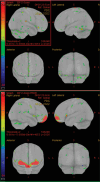Cortical hypometabolism as a predictor of intermittent theta burst stimulation response in treatment-resistant depression patients: An open-label study
- PMID: 39867246
- PMCID: PMC11758971
- DOI: 10.4103/indianjpsychiatry.indianjpsychiatry_161_24
Cortical hypometabolism as a predictor of intermittent theta burst stimulation response in treatment-resistant depression patients: An open-label study
Abstract
Background: Intermittent theta burst stimulation (iTBS) is an accepted and approved brain stimulation technique to treat patients with treatment-resistant depression.
Aim: Using neuroimaging, this open-label study aimed to predict the response by observing glucose metabolism with the help of 18-FDG PET scan.
Methods: A total of 25 treatment-resistant depression patients received 15 sessions of iTBS on the left dorsolateral prefrontal cortex. Two FDG-PET scans were done for all the patients. Fifty-six percent of patients responded to treatment with iTBS.
Results: We found that there was hypometabolism in left and right prefrontal lateral regions, left and right inferior parietal regions, and left prefrontal medial regions at baseline but no statistically significant difference in the metabolism between responders and nonresponders.
Conclusion: We did not find any statistically significant difference in the metabolism between responders and nonresponders in any brain regions at T0 as well as T1. Further large-scale studies are required.
Keywords: Depression; FDG PET; iTBS; neuroimaging; predictors; treatment resistance.
Copyright: © 2024 Indian Journal of Psychiatry.
Conflict of interest statement
There are no conflicts of interest.
Figures


Similar articles
-
Effects of prefrontal theta-burst stimulation on brain function in treatment-resistant depression: A randomized sham-controlled neuroimaging study.Brain Stimul. 2018 Sep-Oct;11(5):1054-1062. doi: 10.1016/j.brs.2018.04.014. Epub 2018 Apr 23. Brain Stimul. 2018. PMID: 29730251 Clinical Trial.
-
Efficacy of intermittent Theta Burst Stimulation (iTBS) and 10-Hz high-frequency repetitive transcranial magnetic stimulation (rTMS) in treatment-resistant unipolar depression: study protocol for a randomised controlled trial.Trials. 2017 Jan 13;18(1):17. doi: 10.1186/s13063-016-1764-8. Trials. 2017. PMID: 28086851 Free PMC article. Clinical Trial.
-
Identifying Neurophysiological Markers of Intermittent Theta Burst Stimulation in Treatment-Resistant Depression Using Transcranial Magnetic Stimulation-Electroencephalography.Biol Psychiatry. 2023 Sep 15;94(6):454-465. doi: 10.1016/j.biopsych.2023.04.011. Epub 2023 Apr 20. Biol Psychiatry. 2023. PMID: 37084864 Clinical Trial.
-
Effectiveness of theta burst versus high-frequency repetitive transcranial magnetic stimulation in patients with depression (THREE-D): a randomised non-inferiority trial.Lancet. 2018 Apr 28;391(10131):1683-1692. doi: 10.1016/S0140-6736(18)30295-2. Epub 2018 Apr 26. Lancet. 2018. PMID: 29726344 Clinical Trial.
-
Efficacy and safety of intermittent theta burst stimulation versus high-frequency repetitive transcranial magnetic stimulation for patients with treatment-resistant depression: a systematic review.Front Psychiatry. 2023 Jul 31;14:1244289. doi: 10.3389/fpsyt.2023.1244289. eCollection 2023. Front Psychiatry. 2023. PMID: 37583841 Free PMC article.
References
-
- Liu X, Mukai Y, Furtek CI, Bortnichak EA, Liaw KL, Zhong W. Epidemiology of treatment-resistant depression in the United States. J Clin Psychiatry. 2021;83:21m13964. doi: 10.4088/JCP. 21m13964. - PubMed
-
- Berlim MT, van den Eynde F, Tovar-Perdomo S, Daskalakis ZJ. Response, remission and drop-out rates following high-frequency repetitive transcranial magnetic stimulation (rTMS) for treating major depression: A systematic review and meta-analysis of randomized, double-blind and sham-controlled trials. Psychol Med. 2014;44:225–39. - PubMed
LinkOut - more resources
Full Text Sources
